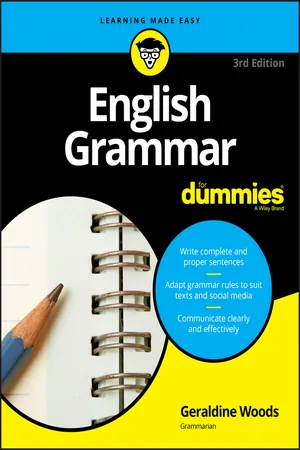
- English
- ePUB (mobile friendly)
- Available on iOS & Android
English Grammar For Dummies
About this book
Get the last word on English grammar
Grasping the intricacies of the English language doesn't need to be tricky, and this down-to-earth guide breaks everything down in ways that make sense—Revealing rules, tips, and tricks to eliminate confusion and gain clarity, English Grammar For Dummies gives you everything you need to communicate with confidence!
Good grammar lays the foundation for speaking and writing clearly. This easy-to-follow book will help you become a more articulate, effective communicator. Covering everything from the building blocks of a sentence to those pesky rules of punctuation, it offers the practical guidance you need to communicate in a way that would make any English teacher proud.
- Improve your speaking skills
- Clearly compose written communications
- Get the latest techniques for continuous improvement
- Write a winning college entrance exam or compelling business presentation
Stop worrying about the grammar police and become more confident with your words!
Frequently asked questions
- Essential is ideal for learners and professionals who enjoy exploring a wide range of subjects. Access the Essential Library with 800,000+ trusted titles and best-sellers across business, personal growth, and the humanities. Includes unlimited reading time and Standard Read Aloud voice.
- Complete: Perfect for advanced learners and researchers needing full, unrestricted access. Unlock 1.4M+ books across hundreds of subjects, including academic and specialized titles. The Complete Plan also includes advanced features like Premium Read Aloud and Research Assistant.
Please note we cannot support devices running on iOS 13 and Android 7 or earlier. Learn more about using the app.
Information
Building a Firm Foundation: The Parts of the Sentence
Using the Right Words at the Right Time



What This Year’s Sentence Is Wearing: Understanding Grammar and Style
- SENTENCE: Am going basketball game I to the.
- WHAT’S WRONG: The word order is scrambled.
- GRAMMAR OR STYLE? Grammar.
- CORRECTED SENTENCE: I am going to the basketball game.
- SENTENCE: She was born on March 18 2009.
- WHAT’S WRONG: Most writers would insert a comma after 18.
- GRAMMAR OR STYLE? Style. Some writers prefer a completely different format for the date.
- CORRECTED SENTENCE: She was born on March 18, 2009. Or, She was born on 18 March 2009.
- SENTENCE: Them enjoy playing baseball.
- WHAT’S WRONG: The word them isn’t appropriate for that spot in the sentence. (Why? Check Chapter 8.)
- GRAMMAR OR STYLE: Grammar.
- CORRECTED SENTENCE: They enjoy playing baseball.
- SENTENCE: Ann spends too much time surfing the Internet.
- WHAT’S WRONG: When it was first invented, “Internet” was generally capitalized. These days, many publications prefer lowercase (internet).
- GRAMMAR OR STYLE: Sty...
Table of contents
- Cover
- Title Page
- Table of Contents
- Introduction
- Part 1: Building a Firm Foundation: The Parts of the Sentence
- Part 2: Clearing Up Confusing Grammar Points
- Part 3: Conventional Wisdom: Punctuation and Capitalization
- Part 4: Polishing Without Wax: The Finer Points of Grammar and Style
- Part 5: The Part of Tens
- About the Author
- Advertisement Page
- Connect with Dummies
- End User License Agreement
